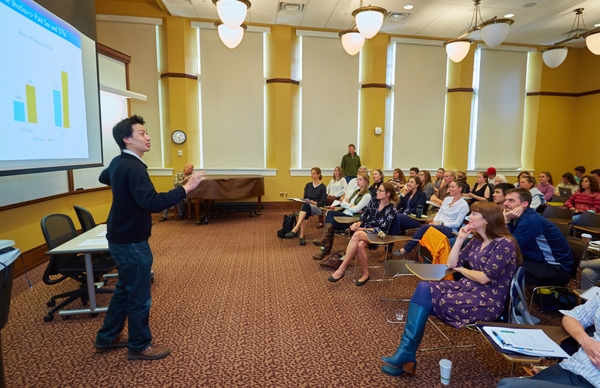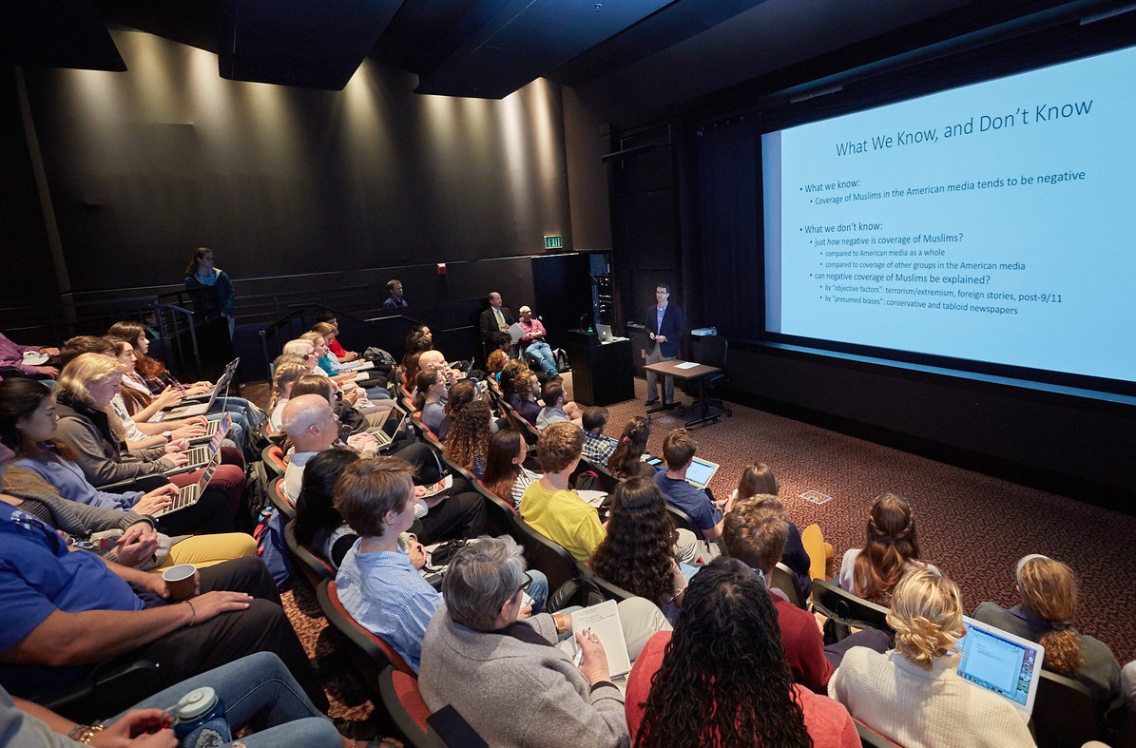New Faculty Forum Offers an ‘Intellectual Feast’ during Fall Family Weekend

MIDDLEBURY, Vt. – Middlebury’s new Fall Faculty Forum, a series of talks presented by faculty members on the first day of Fall Family Weekend, attracted crowds of parents and students alike for an afternoon of thought-provoking conversation.
With families arriving on campus throughout the day on October 13, the faculty forum offered 12 different panel discussions featuring the recent research findings from about 40 different Middlebury professors. The topics ranged from Global Policy Interventions and Queer Politics to the Technologies of Seeing and the Art and Science of the Environment.
The Fall Faculty Forum was designed to provide “an intellectual feast” for family members, students, and the college community at large, said James Ralph, the Rehnquist professor of history and dean of faculty development and research. Professors Jessica Teets (political science) and Jason Mittell (film and media culture, and American studies) organized the inaugural event, which was held in the Axinn Center.
More than 75 people filled Axinn 232 to hear five faculty members discuss their work on the topic of Race and Representation.
“How Black Lives Matter in The Wire” was the subject of Professor Jason Mittell’s talk, which was presented in the format of a 12-minute video.
“Over the past 10 years, film and media scholars have embraced the video essay as a new form of scholarship,” said Mittell. “Rather than publishing an article in a journal, we can create a video that shares what we see and hear, and communicates these ideas using the very form we are analyzing.” Mittell’s video composed of clips from the first season of the HBO television program showed disturbing examples of police brutality against African-Americans.
The presentation titled “Hearing Race in a Single Word: A Study in Experimental Sociophonetics” was offered by two assistant professors of Spanish and linguistics, Brandon Baird and Marcos Rohena-Madrazo. Their study looked at how listeners viewed a speaker who made a “lexically specific phonology switch” in the middle of a sentence, e.g., saying a Spanish word such as “taco” or “piñata” with a Spanish accent. They concluded that listeners are sensitive to phonology switching midsentence, and that their overt and covert attitudes toward the speaker are deeply affected by it.

Professor Erik Bleich of the political science department presented his research on “Media Portrayals of Muslims” in the United States. By analyzing more than 850,000 articles in 17 national and regional newspapers between 1996 and 2016, Bleich concluded that the coverage is “consistently very negative.” Further, he determined that coverage of Muslims is far more negative than articles about other religious, ethnic, or racial groups, and that it can be explained, in part, by the volume of stories that focus on terrorism or extremism in the U.S. Bleich also pointed to a phenomenon he terms the “Muslim gap” in news coverage, and he infers that it is caused by media bias.
Shawna Shapiro, associate professor of writing and linguistics, concluded the session on Race and Representation with findings from her research project on “Deficit Discourse and the Education of Refuge-Background Students.” Conducted in Burlington, Vt., Shapiro sought to learn: What do refugee-background students perceive as deficit discourse? What impact does this discourse have on their experiences in school? And how can deficit discourse be resisted in classrooms, schools, and community? Her findings determined in part that “deficit discourse” focused on the refugee-background students’ victimization, trauma, survival, and desire for help, rather than “asset discourse” that concentrated on their need for agency, resilience, success, and willingness to help others.
Later on Friday, four Middlebury faculty members looked at the Technologies of Seeing from across a wide spectrum of academic disciplines.
Assistant Professor of Physics Michael Durst discussed his biomedical optics research, which some day may allow high-resolution laser imaging of human tissue at the cellular level without an incision. He compared his work to ultrasound, except that his work deals with light rather than sound. Durst noted that this area of research is well-suited to undergraduate learning and enriching students’ understanding of physics.
From a completely different academic perspective, Christian Keathley, professor of film and media culture, talked about his work in bringing the art of videographic essays to the film studies field. Film scholars, he noted, have always had to rely on writing to convey their ideas about a medium built on sights and sounds. A proliferation of multimedia tools in recent years has opened up exciting new avenues for these scholars to contribute work to the field of film criticism. Together, Keathley and Jason Mittell founded [in]Transition, a journal of videographic film and moving image studies.
Keathley’s colleague in the Department of Film and Media Culture, Professor Leger Grindon, discussed his research on the historical use of re-enactments in documentary filmmaking. The technical limitations of early filmmaking often required reenactments to capture the story, but the practice gradually faded as equipment became more portable. Grindon showed clips from Errol Morris’s 1988 documentary The Thin Blue Line, which reinvented the role of re-enactment in a documentary film.
Professor Daniel Scharstein from the Department of Computer Science closed out the session with a snapshot of his longstanding research on computer vision, a field which has spawned such inventions as facial recognition software and 3D object recognition. Scharstein and his students have created a system of benchmarks by which computer developers from around the world measure the accuracy of their computer vision programming.
Each presentation was followed with a question and answer session with the faculty researchers.

